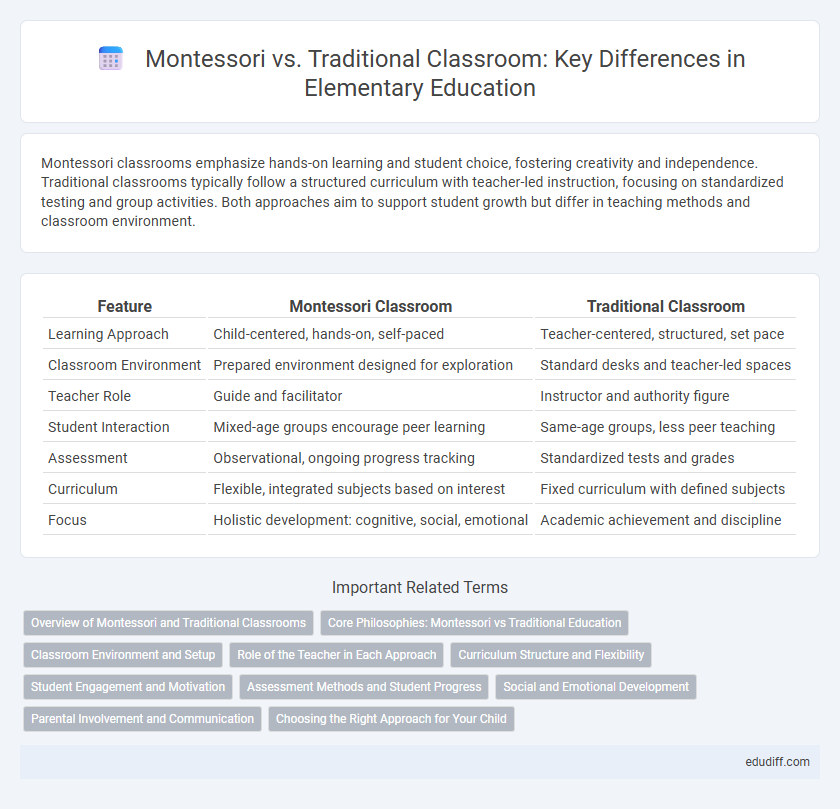Montessori classrooms emphasize hands-on learning and student choice, fostering creativity and independence. Traditional classrooms typically follow a structured curriculum with teacher-led instruction, focusing on standardized testing and group activities. Both approaches aim to support student growth but differ in teaching methods and classroom environment.
Table of Comparison
| Feature | Montessori Classroom | Traditional Classroom |
|---|---|---|
| Learning Approach | Child-centered, hands-on, self-paced | Teacher-centered, structured, set pace |
| Classroom Environment | Prepared environment designed for exploration | Standard desks and teacher-led spaces |
| Teacher Role | Guide and facilitator | Instructor and authority figure |
| Student Interaction | Mixed-age groups encourage peer learning | Same-age groups, less peer teaching |
| Assessment | Observational, ongoing progress tracking | Standardized tests and grades |
| Curriculum | Flexible, integrated subjects based on interest | Fixed curriculum with defined subjects |
| Focus | Holistic development: cognitive, social, emotional | Academic achievement and discipline |
Overview of Montessori and Traditional Classrooms
Montessori classrooms emphasize student-led learning with mixed-age groups and hands-on materials designed to foster independence and creativity. Traditional classrooms typically follow a teacher-directed model with age-specific classes, structured lessons, and standardized assessments to ensure curriculum adherence. Both approaches aim to develop foundational skills, but Montessori nurtures self-paced exploration while traditional settings prioritize uniform instruction.
Core Philosophies: Montessori vs Traditional Education
Montessori education emphasizes self-directed learning, encouraging children to explore materials at their own pace to foster independence and intrinsic motivation. Traditional classrooms often rely on teacher-led instruction with a standardized curriculum designed to ensure uniform skill acquisition and assessment. The Montessori method integrates sensory-based, hands-on activities promoting holistic development, whereas traditional education prioritizes structured lessons aimed at cognitive mastery and social conformity.
Classroom Environment and Setup
Montessori classrooms feature child-centered environments with low shelves, natural materials, and open spaces that encourage independent exploration and hands-on learning. Traditional classrooms often have teacher-centered layouts with rows of desks, standardized materials, and structured seating arrangements that emphasize direct instruction. The Montessori setup fosters autonomy and creativity, while traditional classrooms prioritize order and uniformity.
Role of the Teacher in Each Approach
In a Montessori classroom, the teacher acts as a guide, facilitating self-directed learning and observing each child's individual needs to provide tailored support. In contrast, the teacher in a traditional classroom typically directs instruction, manages the curriculum, and leads structured lessons to ensure standardized learning outcomes. The Montessori approach emphasizes fostering independence through a prepared environment, while the traditional model prioritizes teacher-led guidance and assessment.
Curriculum Structure and Flexibility
Montessori curriculum emphasizes individualized learning paths with flexible pacing, allowing students to explore subjects based on their interests and developmental readiness. Traditional classroom curriculum follows a standardized, fixed schedule with predetermined content and pacing designed to meet grade-level benchmarks. This flexibility in Montessori promotes deeper engagement and self-directed learning compared to the structured, teacher-led approach in traditional settings.
Student Engagement and Motivation
Montessori classrooms foster student engagement through hands-on learning and self-paced activities, promoting intrinsic motivation by encouraging curiosity and independence. In contrast, traditional classrooms often rely on teacher-directed instruction and standardized curricula, which may limit student autonomy and reduce motivation. Research indicates that Montessori students exhibit higher levels of sustained attention and enthusiasm for learning due to the empowering learning environment.
Assessment Methods and Student Progress
Montessori classrooms emphasize formative assessment through observation and individualized portfolios, allowing teachers to tailor instruction to each student's development. Traditional classrooms often rely on summative assessments such as standardized tests and quizzes to measure student progress at set intervals. This difference highlights Montessori's focus on continuous, personalized feedback versus traditional methods' emphasis on benchmark evaluations.
Social and Emotional Development
Montessori classrooms foster social and emotional development by encouraging collaboration, independence, and self-regulation through mixed-age groups and hands-on activities. Traditional classrooms often emphasize structured routines and teacher-led interactions, which can support social skills but may limit opportunities for autonomous emotional growth. Research shows that Montessori environments promote greater empathy, self-confidence, and conflict resolution skills among elementary students.
Parental Involvement and Communication
Parental involvement plays a crucial role in both Montessori and traditional elementary classrooms, with Montessori emphasizing regular, open communication and active participation in the child's learning process. Montessori classrooms encourage parents to engage in observational visits and detailed progress reports, fostering a collaborative relationship between educators and families. Traditional classrooms often rely on scheduled parent-teacher conferences and standardized report cards, which can limit ongoing dialogue but provide structured updates on academic performance.
Choosing the Right Approach for Your Child
Montessori classrooms emphasize self-directed learning and hands-on activities, allowing children to explore at their own pace and develop independence. Traditional classrooms often follow a structured curriculum with teacher-led instruction, promoting consistency and clear expectations. Assessing your child's learning style and needs can help determine whether a Montessori or traditional approach best supports their academic and social growth.
Montessori vs Traditional Classroom Infographic

 edudiff.com
edudiff.com